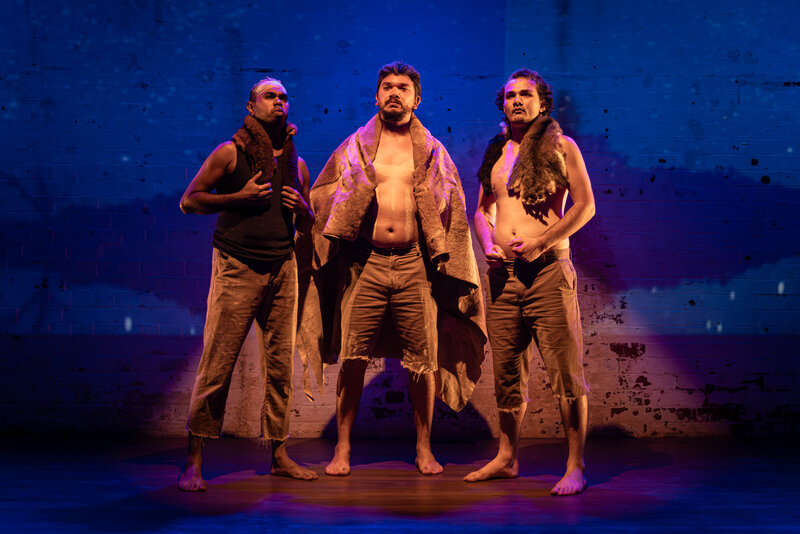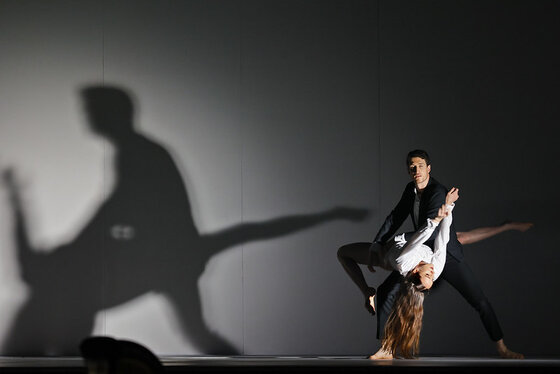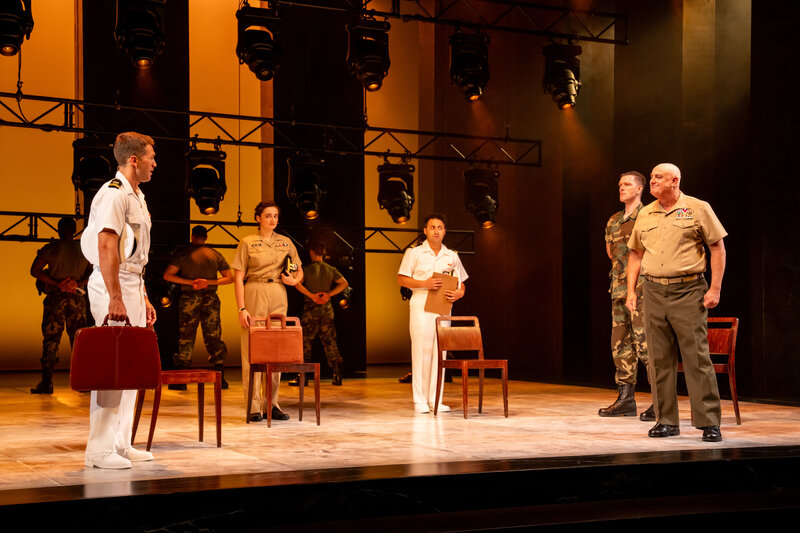George Bernard Shaw wrote Saint Joan, in 1923, six scenes and an epilogue. Imara Savage, the Director of this production, has ambitiously taken many liberties with the original text.
This Sydney Theatre Company production of Saint Joan occupies the stage for one hour and forty-five minutes, straight through, without an interval. A great deal of Shaw’s play is absent. Then, following the severe edit of Shaw’s great play, to achieve her desire to have a play about Saint Joan to have the female actor as the central focus, Ms Savage, with Emme Hoy, a writer, part of the Sydney Theatre Company’s Emerging Writer’s Group, have introduced new monologues into the text. There are, as well, other ‘robust’ contemporary interpolations, from these two artists, throughout the play.
 The production begins with a still, seated gleaming silver armoured figure centre stage in light, surrounded by a towering cyclorama curtain, set design by David Fleischer; lighting design, by Nick Schlepper; accompanied by an imposing sound score from Max Lyandvert. The costumes are a quasi period/modern look – mostly in black – by Renee Mulder. All these elements are of great affect, particularly the contribution from Mr Lyandvert. On the front edge of the stage appear an English earl (David Whitney), an English priest (Sean O’Shea) and a French bishop (William Zappa) and we are thrown into the debate of Scene Four of the original play, as the strategy for the trial of Joan is essayed. This sets the framework of this production where Joan seated centre, mostly, is surrounded, by the men (the patriarchy) in a fairly ‘stylised’ physical mode, so that her journey as a sixteen year old farm girl to warrior commander of the French army, to condemned prisoner of war, a heretic, to be burnt to death at the stake, like a witch (at the age of nineteen), is told in a formula of formalised staged flashback.
The production begins with a still, seated gleaming silver armoured figure centre stage in light, surrounded by a towering cyclorama curtain, set design by David Fleischer; lighting design, by Nick Schlepper; accompanied by an imposing sound score from Max Lyandvert. The costumes are a quasi period/modern look – mostly in black – by Renee Mulder. All these elements are of great affect, particularly the contribution from Mr Lyandvert. On the front edge of the stage appear an English earl (David Whitney), an English priest (Sean O’Shea) and a French bishop (William Zappa) and we are thrown into the debate of Scene Four of the original play, as the strategy for the trial of Joan is essayed. This sets the framework of this production where Joan seated centre, mostly, is surrounded, by the men (the patriarchy) in a fairly ‘stylised’ physical mode, so that her journey as a sixteen year old farm girl to warrior commander of the French army, to condemned prisoner of war, a heretic, to be burnt to death at the stake, like a witch (at the age of nineteen), is told in a formula of formalised staged flashback.
This production has been supercharged by an abundance of talent where the creation of characters of human dimension (not just talking heads, often the signal, bane, of a ‘bad’ production of Shaw’s work) have imaginatively been fleshed out by all, to bring the surviving crisp Shavian language and debate to a passionate and easily absorbed communication, through a no-frills intelligence and utilisation of technical instruments (mostly) alert to the speedy needs of the original writer. Its clarity and speed is a tonic of flattery that not many contemporary productions give an audience credit to have to bring to the performances, as part of their contribution to the ‘joy’ of being in the live theatre. The irony and quirky humour – Shaw after all is Irish, and a provocateur – is a privilege to respond to (there has been too much edit of Shaw’s audacious wit for my money). The new writing from Ms Savage and Hoy serves their modern desire, slant/need of this production well enough but is distinguished and is in contrast to the surety of Shaw’s language pertinency, and has a slightly romantic emotional tone – Shaw would be embarrassed by such a gesture – not quite sentimental but only just short of it in its ‘perfumed’ and sometimes overladen imagery. Shaw is blunt and hard – gleaming, cold, silver metal – Savage and Hoy are liquid and warm – melliflious honey, saturated yellow. Shaw is a debator and humorist. Savage and Hoy descriptive and earnest. However, this company of actors make the writing from these two different sources – one male, one female nearly a century apart – coalesce and appear as one and consistent in tone.
Mr Whitney (we see him not often enough on our major stages) is deftly amusing. Mr O’Shea comically attuned – it is a loss to to have his character’s Shavian impassioned turnaround later in the play removed – edited out – which would have given him more character and less ‘comic racist’ caricature to deliver. Mr Zappa is an exemplar of the requirements that Classic work of this kind demand: physically, vocally armed with insightful intellectual clarity, all harnessed for us, with exquisite economy – splendid to have him onstage again and demonstrating the range of his skills with the contrast of the naturalism he so subtly executed recently in the STC’s production of The Children to savour. John Gaden, likewise, is firing full throttle with relish for his Shavian challenges as the Inquisitor and Archbishop, delighting in contrast to the recent banality of the text of Diplomacy. Gareth Davies, Brandon McClelland, Socratis Otto and Anthony Taufa support the directorial demands with energy and precision, to keep the production moving with focused meaning and drive, each grasping the baton of responsibility, when it is thrust at/to them, with enthusiasm and zeal.
Any production of Saint Joan must stand or fall with the actor of Joan. Recognising the gifts of Sarah Snook (who is making her debut with the STC – really?) Ms Savage has been able to confidently present her vision of Joan with absolute surety. Ms Snook, has the full-blooded technical skills of Voice and Body of a top-flight actor, and is armed with a ferocious intellect and a capacity to be immersed in the dilemma of her character with a luminous translucence that is able to give us both the internal and external ‘life-force’ of the girl/woman and the saint. There is not a minute on the stage, and she occupies it the entire length of the production, where she is not radiating a second-by-second experience – she has no down time, no rest – she is inhabiting Joan, seemingly possessed – it is the stuff of unforgettable ‘acting’. I was fortunate to attend her performance (twice) as Hilde Wangel in Ibsen’s The Master Builder at the Old Vic, with Ralph Fiennes, a year or so ago. Ms Snook’s performance here, confirms and supersedes that achievement. Ms Snook certainly gave Mr Fiennes a run-for-his talent! Shaw was a great admirer of Ibsen and both writers were enthralled by the ‘life force’ philosophy of Friedrich Nietzsche. Both Joan and Hilde are women possessed of the irresistible force of life. It seems Sarah Snook maybe as well. Her gifts in this performance is a bounty for us to never forget.
 I recently saw at the Seymour Centre an interesting one woman piece called Joan, looking at the legend of Saint Joan. Its insights were refreshing (and amusing). Too, Ms Savage has created a unique approach to such an historical figure and famous play (Shaw won the Nobel Prize for Literature, not long after the writing of Saint Joan) and attempts to mirror that energy, courage and achievement with teenage ‘heroes’ of our present time, in program reference: Emma Gonzalez (American leader against the gun lobby in the USA) and Malala Yousafzai, the women of Pussy Riot. While not really connecting the contemporaries dots to Joan there is a resonance – give or take a thought argument.
I recently saw at the Seymour Centre an interesting one woman piece called Joan, looking at the legend of Saint Joan. Its insights were refreshing (and amusing). Too, Ms Savage has created a unique approach to such an historical figure and famous play (Shaw won the Nobel Prize for Literature, not long after the writing of Saint Joan) and attempts to mirror that energy, courage and achievement with teenage ‘heroes’ of our present time, in program reference: Emma Gonzalez (American leader against the gun lobby in the USA) and Malala Yousafzai, the women of Pussy Riot. While not really connecting the contemporaries dots to Joan there is a resonance – give or take a thought argument.
The STC’s production of Saint Joan is a Reader’s Digest version of the original play, and could be a disappointment if you have come to see the STC advertised (apparently, falsely) Saint Joan by George Bernard Shaw. But is, nonetheless, a very thrilling hybrid with enough Shaw for you to recognise the originator and with enough impassioned personal point-of-view of the director (and Ms Hoy, I presume), for you to have a very exciting night in the theatre. The production values are clean and outstanding and the acting is of a uniform quality not seen often enough in Sydney. And not to see the work, the performance given, wrought, lived, by Sarah Snook would be an act of misdemeanour by any theatre lover. Not to be missed.
Saint Joan is at the Roslyn Packer Theatre, Walsh Bay till 30 June 2018
Kevin Jackson
For more of Kevin Jackson’s theatre reviews, check out his blog at Kevin Jackson’s Theatre Diary
Other reviews you might enjoy:
- Pygmalion (New Theatre) – theatre review
- Dinner (STC) – theatre review
- Mother (Belvoir) – theatre review

David Edwards is the former editor of The Blurb and a contributor on film and television





